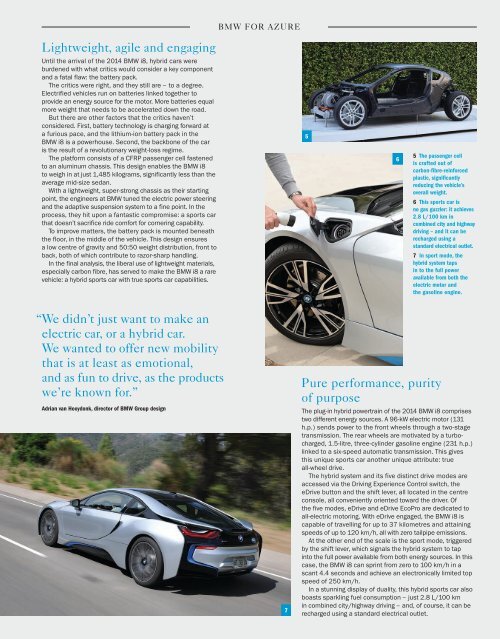AZURE_2014_07_08.pdf
You also want an ePaper? Increase the reach of your titles
YUMPU automatically turns print PDFs into web optimized ePapers that Google loves.
BMW FOR <strong>AZURE</strong><br />
Lightweight, agile and engaging<br />
Until the arrival of the <strong>2014</strong> BMW i8, hybrid cars were<br />
burdened with what critics would consider a key component<br />
and a fatal flaw: the battery pack.<br />
The critics were right, and they still are – to a degree.<br />
Electrified vehicles run on batteries linked together to<br />
provide an energy source for the motor. More batteries equal<br />
more weight that needs to be accelerated down the road.<br />
But there are other factors that the critics haven’t<br />
considered. First, battery technology is charging forward at<br />
a furious pace, and the lithium-ion battery pack in the<br />
BMW i8 is a powerhouse. Second, the backbone of the car<br />
is the result of a revolutionary weight-loss regime.<br />
The platform consists of a CFRP passenger cell fastened<br />
to an aluminum chassis. This design enables the BMW i8<br />
to weigh in at just 1,485 kilograms, significantly less than the<br />
average mid-size sedan.<br />
With a lightweight, super-strong chassis as their starting<br />
point, the engineers at BMW tuned the electric power steering<br />
and the adaptive suspension system to a fine point. In the<br />
process, they hit upon a fantastic compromise: a sports car<br />
that doesn’t sacrifice ride comfort for cornering capability.<br />
To improve matters, the battery pack is mounted beneath<br />
the floor, in the middle of the vehicle. This design ensures<br />
a low centre of gravity and 50:50 weight distribution, front to<br />
back, both of which contribute to razor-sharp handling.<br />
In the final analysis, the liberal use of lightweight materials,<br />
especially carbon fibre, has served to make the BMW i8 a rare<br />
vehicle: a hybrid sports car with true sports car capabilities.<br />
5<br />
6<br />
5 The passenger cell<br />
is crafted out of<br />
carbon-fibre-reinforced<br />
plastic, significantly<br />
reducing the vehicle’s<br />
overall weight.<br />
6 This sports car is<br />
no gas guzzler: it achieves<br />
2.8 L/100 km in<br />
com bined city and highway<br />
driving – and it can be<br />
recharged using a<br />
standard electrical outlet.<br />
7 In sport mode, the<br />
hybrid system taps<br />
in to the full power<br />
available from both the<br />
electric motor and<br />
the gasoline engine.<br />
“We didn’t just want to make an<br />
electric car, or a hybrid car.<br />
We wanted to offer new mobility<br />
that is at least as emotional,<br />
and as fun to drive, as the products<br />
we’re known for.”<br />
Adrian van Hooydonk, director of BMW Group design<br />
7<br />
Pure performance, purity<br />
of purpose<br />
The plug-in hybrid powertrain of the <strong>2014</strong> BMW i8 comprises<br />
two different energy sources. A 96-kW electric motor (131<br />
h.p.) sends power to the front wheels through a two-stage<br />
transmission. The rear wheels are motivated by a turbocharged,<br />
1.5-litre, three- cylinder gasoline engine (231 h.p.)<br />
linked to a six-speed automatic transmission. This gives<br />
this unique sports car another unique attribute: true<br />
all-wheel drive.<br />
The hybrid system and its five distinct drive modes are<br />
accessed via the Driving Experience Control switch, the<br />
eDrive button and the shift lever, all located in the centre<br />
console, all conveniently oriented toward the driver. Of<br />
the five modes, eDrive and eDrive EcoPro are dedicated to<br />
all-electric motoring. With eDrive engaged, the BMW i8 is<br />
capable of travelling for up to 37 kilometres and attaining<br />
speeds of up to 120 km/h, all with zero tailpipe emissions.<br />
At the other end of the scale is the sport mode, triggered<br />
by the shift lever, which signals the hybrid system to tap<br />
into the full power available from both energy sources. In this<br />
case, the BMW i8 can sprint from zero to 100 km/h in a<br />
scant 4.4 seconds and achieve an electronically limited top<br />
speed of 250 km/h.<br />
In a stunning display of duality, this hybrid sports car also<br />
boasts sparkling fuel consumption – just 2.8 L/100 km<br />
in combined city/highway driving – and, of course, it can be<br />
recharged using a standard electrical outlet.


















